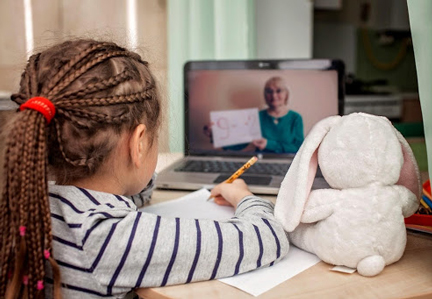
By Linda Conlin, Pro to Pro Managing Editor
It’s clear that “back to school” has a very different meaning this year. U.S. News and World Report cited data from Education Week in reporting that 21 of the 25 biggest U.S. school districts are opting to go remote-learning-only this fall, with many others having hybrid (part virtual, part in-person) classes. Either way, we are assured of increased screen time for children and with it, an increased risk of vision problems.
As digital device use has increased, so have vision problems. According to U.S. Census Bureau data, by 1989, about 30% of households with children under 18 owned a computer. That increased to 65% in 2000. Currently, The Vision Council reports that 70% of American adults say that their children have more than two hours of screen time a day, but an alarming 25% are not concerned about the impact on their child’s eyes and vision. Last year, Langis Michaud, professor at the University of Montreal School of Optometry wrote, “a rapid increase in visual problems has been noted since the introduction of the smartphone in 2007. While the device itself does not emit harmful radiation, it requires the user to read its screen at a distance of 20 cm rather than the normal distance of 45 cm to 50 cm. It has been suggested that this close distance boosts the risk of developing myopia by eight times, especially if both parents are myopic.”
It isn’t only adults working on computers who can have symptoms of digital eye strain (DES), children can, too, plus an increased risk of myopia. Manifestations of DES include blurred vision, diplopia, dry eyes, eye irritation, headaches and neck or back pain. It’s important to note that children may not complain of these things because they can’t express them properly, but may become irritable, tired or resist completing their work. Children can lose track of time when they are engaged in screen activity, and not give their eyes needed breaks. Glare and incorrect lighting are problematic, too, as are posture and screen position.
As ECPs, we must alert our adult patients to the risks hours spent on digital devices pose to their children’s vision. First and foremost, every child should have a comprehensive eye exam by age 5. Children should follow the 20/20/20 rule to look at something 20 feet away for twenty seconds after every 20 minutes of screen time. A timer or program that turns the screen off automatically is a helpful reminder. Screens should be positioned approximately 18 inches away from the eyes, with the child looking slightly down, not up, and lighting positioned to eliminate glare. Outside of schoolwork, use of digital devices should be limited, and outdoor activities encouraged. This school year will be particularly challenging for children’s learning as well as their vision. Let’s get the word out about healthy vision habits that can help make learning a little easier.
You can learn about a new measurement and treatment solution for DES with our CE, Neurolens: A Breakthrough Solution for Headaches, Neck Tension and Digital Eyestrain, at 2020mag.com/ce. This course is free courtesy of an educational grant from Neurolens, Inc.











